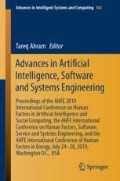Abstract
In the last decade, machine learning has increasingly been utilized for solving various types of problems in different domains, such as, manufacturing finance, and healthcare. However, designing and fine-tuning algorithms require extensive expertise in artificial intelligence. Although many software packages wrap the complexity of machine learning and simplify their use, programming skills are still needed for operating algorithms and interpreting their results. Additionally, as machine learning experts and non-technical users have different backgrounds and skills, they experience issues in exchanging information about requirements, features, and structure of input and output data.
This paper introduces a meta-language based on the Goal-Question-Metric paradigm to facilitate the design of machine learning algorithms and promote end-user development. The proposed methodology was initially developed to formalize the relationship between conceptual goals, operational questions, and quantitative metrics, so that measurable items can help quantify qualitative goals. Conversely, in our work, we apply it to machine learning with a two-fold objective: (1) empower non-technical users to operate artificial intelligence systems, and (2) provide all the stakeholders, such as, programmers and domain experts, with a modeling language.
Access this chapter
Tax calculation will be finalised at checkout
Purchases are for personal use only
References
Nasrabadi, N.M.: Pattern recognition and machine learning. J. Electron. Imaging 16(4), 049901 (2007)
Sebastiani, F.: Machine learning in automated text categorization. ACM Comput. Surv. (CSUR) 34(1), 1–47 (2002)
Abadi, M., Barham, P., Chen, J., Chen, Z., Davis, A., Dean, J., Devin, M., Ghemawat, S., Irving, G., Isard, M., Kudlur, M.: TensorFlow: a system for large-scale machine learning. In: OSDI, vol. 16, pp. 265–283, November 2016
Chen, T., Li, M., Li, Y., Lin, M., Wang, N., Wang, M., Xiao, T., Xu, B., Zhang, C., Zhang, Z.: MXNet: a flexible and efficient machine learning library for heterogeneous distributed systems. arXiv preprint arXiv:1512.01274 (2015)
The Microsoft Cognition Toolkit (CNTK). https://cntk.ai
Pedregosa, F., Varoquaux, G., Gramfort, A., Michel, V., Thirion, B., Grisel, O., Blondel, M., Prettenhofer, P., Weiss, R., Dubourg, V., Vanderplas, J.: Scikit-learn: machine learning in Python. J. Mach. Learn. Res. 12, 2825–2830 (2011)
Paszke, A., Gross, S., Chintala, S., Chanan, G., Yang, E., DeVito, Z., Lin, Z., Desmaison, A., Antiga, L., Lerer, A.: Automatic differentiation in PyTorch (2017)
Erickson, B.J., Korfiatis, P., Akkus, Z., Kline, T., Philbrick, K.: Toolkits and libraries for deep learning. J. Digit. Imaging 30(4), 400–405 (2017)
Burrell, J.: How the machine ‘thinks’: understanding opacity in machine learning algorithms. Big Data Soc. 3(1), 2053951715622512 (2016)
Bach, M.P., Zoroja, J., Vukšić, V.B.: Determinants of firms’ digital divide: a review of recent research. Procedia Technol. 9, 120–128 (2013)
Jordan, M.I., Mitchell, T.M.: Machine learning: trends, perspectives, and prospects. Science 349(6245), 255–260 (2015)
De Pace, A., Galeandro, P., Trotta, G.F., Caporusso, N., Marino, F., Alberotanza, V., Scardapane, A.: Synthesis of a neural network classifier for hepatocellular carcinoma grading based on triphasic CT images. In: Recent Trends in Image Processing and Pattern Recognition: First International Conference, RTIP2R 2016, Bidar, India, 16–17 December 2016, Revised Selected Papers, vol. 709, p. 356. Springer, April 2017. https://doi.org/10.1007/978-3-319-60483-1_13
Bevilacqua, V., Uva, A.E., Fiorentino, M., Trotta, G.F., Dimatteo, M., Nasca, E., Nocera, A.N., Cascarano, G.D., Brunetti, A., Caporusso, N., Pellicciari, R.: A comprehensive method for assessing the blepharospasm cases severity. In: International Conference on Recent Trends in Image Processing and Pattern Recognition, pp. 369–381. Springer, Singapore, December 2016. https://doi.org/10.1007/978-981-10-4859-3_33
Bevilacqua, V., Trotta, G.F., Loconsole, C., Brunetti, A., Caporusso, N., Bellantuono, G.M., De Feudis, I., Patruno, D., De Marco, D., Venneri, A., Di Vietro, M.G.: A RGB-D sensor based tool for assessment and rating of movement disorders. In: International Conference on Applied Human Factors and Ergonomics, pp. 110–118. Springer, Cham, July 2017. https://doi.org/10.1007/978-3-319-60483-1_12
Bevilacqua, V., Trotta, G.F., Brunetti, A., Caporusso, N., Loconsole, C., Cascarano, G.D., Catino, F., Cozzoli, P., Delfine, G., Mastronardi, A., Di Candia, A.: A comprehensive approach for physical rehabilitation assessment in multiple sclerosis patients based on gait analysis. In: International Conference on Applied Human Factors and Ergonomics, pp. 119–128. Springer, Cham, July 2017. https://doi.org/10.1007/978-3-319-60483-1_13
LeCun, Y., Bengio, Y., Hinton, G.: Deep learning. Nature 521(7553), 436 (2015)
Gerbert, P., Hecker, M., Steinhäuser, S., Ruwolt, P.: Putting artificial intelligence to work. BCG Henderson Institute, The Boston Consulting Group, Munich, Germany (2017). Accessed 22 Jan 2018
Almassy, N., Kohle, M., Schonbauer, F.: Condela-3: a language for neural networks. In: 1990 IJCNN International Joint Conference on Neural Networks, pp. 285–290. IEEE, June 1990
Basili, V.R.: Software modeling and measurement: the goal/question/metric paradigm (1992)
Caldiera, V.R.B.G., Rombach, H.D.: Goal question metric paradigm. Encycl. Softw. Eng. 1, 528–532 (1994)
Fontana, F.A., Zanoni, M., Marino, A., Mantyla, M.V.: Code smell detection: towards a machine learning-based approach. In: 2013 29th IEEE International Conference on Software Maintenance (ICSM), pp. 396–399. IEEE, September 2013
Uchiyama, S., Washizaki, H., Fukazawa, Y., Kubo, A.: Design pattern detection using software metrics and machine learning. In: First International Workshop on Model-Driven Software Migration (MDSM 2011), p. 38, March 2011
Sarcià, S.A., Cantone, G., Basili, V.R.: A statistical neural network framework for risk management process. In: Proceedings of ICSOFT, Barcelona, SP (2007)
Werner, E., Grabowski, J., Neukirchen, H., Röttger, N., Waack, S., Zeiss, B.: TTCN-3 quality engineering: using learning techniques to evaluate metric sets. In: International SDL Forum, pp. 54–68. Springer, Heidelberg, September 2007
Gasson, S.: Analyzing key decision-points: problem partitioning in the analysis of tightly-coupled, distributed work-systems. Int. J. Inf. Technol. Syst. Approach (IJITSA) 5(2), 57–83 (2012)
Rumbaugh, J., Booch, G., Jacobson, I.: The Unified Modeling Language Reference Manual. Addison Wesley, Boston (2017)
Author information
Authors and Affiliations
Corresponding author
Editor information
Editors and Affiliations
Rights and permissions
Copyright information
© 2020 Springer Nature Switzerland AG
About this paper
Cite this paper
Caporusso, N., Helms, T., Zhang, P. (2020). A Meta-Language Approach for Machine Learning. In: Ahram, T. (eds) Advances in Artificial Intelligence, Software and Systems Engineering. AHFE 2019. Advances in Intelligent Systems and Computing, vol 965. Springer, Cham. https://doi.org/10.1007/978-3-030-20454-9_19
Download citation
DOI: https://doi.org/10.1007/978-3-030-20454-9_19
Published:
Publisher Name: Springer, Cham
Print ISBN: 978-3-030-20453-2
Online ISBN: 978-3-030-20454-9
eBook Packages: EngineeringEngineering (R0)

